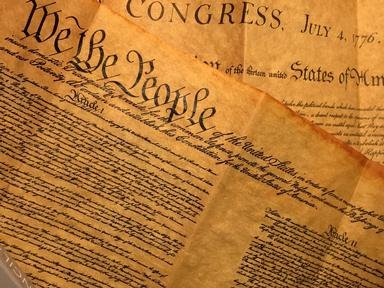Quiz Answer Key and Fun Facts
1. Adopted in June 1788, the United States Constitution consists of seven articles. The three branches of the federal government are outlined by the first three articles. Which of the remaining four articles governs how the Constitution may be amended?
2. Only two restrictions are placed on what can be amended. The first is a restriction on abolishing the slave trade before the year 1808. What is the second restriction?
3. There are two methods in which an amendment may be ratified by the states. This can be achieved through either the state legislatures or state conventions held for that purpose. Prior to the end of the twentieth century, the latter method was employed only once. Which amendment was the first to be ratified by state conventions?
4. One of the fundamental principles of the Constitution is the system of checks and balances: the idea that each branch should check and balance the other to prevent any potential abuse of power. One example of this is that Congress can overturn Supreme Court decisions by amending the Constitution. Prior to the end of the twentieth century, how many amendments were proposed with the intention of overturning a Supreme Court decision?
5. The Twelfth Amendment revised procedures for how the president is elected. It stipulates that the vice president is elected along with the president on a joint ticket, thereby introducing the concept of a running mate that we are familiar with today. The Twelfth Amendment first applied in which election?
6. Section I of the Twentieth Amendment provides that the president and vice president are to be inaugurated on the twentieth of January and congressional terms begin on the third of January. However, the need for the amendment was necessary; the swearing-in ceremonies of the president and Congress were held on the fourth of March following elections of the previous November. Who was the first president to be inaugurated on the twentieth of January?
7. Ratified in February 1951, the Twenty-Second Amendment limits how many times a president may be elected. When the provisions of the amendment became effective in January 1953, what was the maximum amount of years a president could serve?
8. The Twenty-Third Amendment is the second amendment to concern the Electoral College, after the Twelfth Amendment. It grants the participation of the District of Columbia in presidential elections. The Twenty-Third Amendment first applied in which election?
9. Ratified in February 1967, the Twenty-Fifth Amendment revises presidential succession. Which provision empowers the president to appoint a new vice president if a vacancy exists in that office?
10. Ratified in May 1992, the Twenty-Seventh Amendment is an oddity among the amendments due to the length of time it took to be ratified by the states. In what year was the amendment proposed?
Source: Author
Cuish
This quiz was reviewed by FunTrivia editor
trident before going online.
Any errors found in FunTrivia content are routinely corrected through our feedback system.
